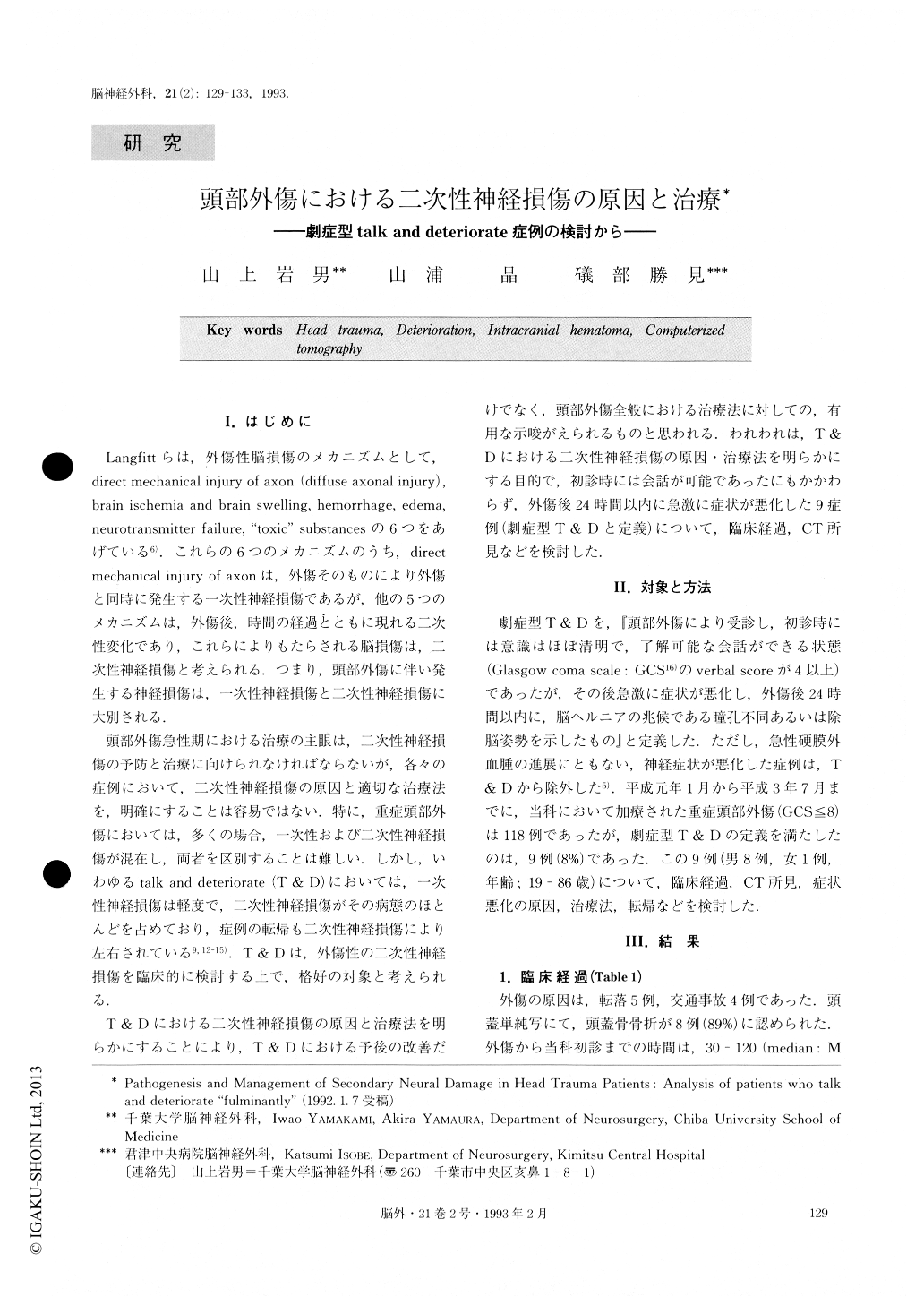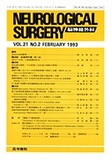Japanese
English
- 有料閲覧
- Abstract 文献概要
- 1ページ目 Look Inside
I.はじめに
Langfittらは,外傷性脳損傷のメカニズムとして,direct mechanical injury of axon(diffuse axonal injury),brain ischemia and brain swelling, hemorrhage, edema,neurotransmitter failure,“toxic”substancesの6つをあげている6).これらの6つのメカニズムのうち,directmechanical injury of axonは,外傷そのものにより外傷と同時に発生する一次性神経損傷であるが,他の5つのメカニズムは,外傷後,時間の経過とともに現れる二次性変化であり,これらによりもたらされる脳損傷は,二次性神経損傷と考えられる.つまり,頭部外傷に伴い発生する神経損傷は,一次性神経損傷と二次性神経損傷に大別される.
頭部外傷急性期における治療の主眼は,二次性神経損傷の予防と治療に向けられなければならないが,各々の症例において,二次性神経損傷の原因と適切な治療法を,明確にすることは容易ではない.特に,重症頭部外傷においては,多くの場合,一次性および二次性神経損傷が混在し,両者を区別することは難しい.しかし,いわゆるtalk and deteriorate(T & D)においては,一次性神経損傷は軽度で,二次性神経損傷がその病態のほとんどを占めており,症例の転帰も二次性神経損傷により左右されている9,12-15).T & Dは,外傷性の二次性神経損傷を臨床的に検討する上で,格好の対象と考えられる.
To clarify the pathogenesis and management of secondary neural damage after head trauma, we char-acterized the clinical features and CT findings in nine patients who talked and deteriorated “fulminantly”. The patient who talks and deteriorates “fulminantly” is defined as a patient who talks (verbal score of Glas-gow Coma Scale 4) on admission, and subsequently shows a rapid neurological deterioration to develop an anisocoria and/or a decerebrated posture within 24 hours after trauma. Nine (8%) out of 118 patients with severe head trauma satisfied the definition mentioned above.
The mechanism of injury was a fall in 5 patients and a road traffic accident in 4. Plain skull X-ray manifested a linear skull fracture in 8 out of 9 (89%) . Although they were almost alert and talked on admission, all of these 9 patients developed an anisocoria within 6 hours after trauma. Prior to the rapid neurological deteriora-tion, in spite of their good consciousness, they charac-teristically showed a variety of CT abnormalities in-cluding subdural hematoma (SDH), intracerebral hema-toma (ICH) and subarachnoid hemorrhage. Following the rapid neurological deterioration, 7 out of 9 patients underwent surgical treatment for hematoma evacuation using a large decompressive craniectomy. Clinical out-comes were 2 good recoveries, 1 moderate disability, and 6 deaths. Causes of the rapid neurological de-terioration determined by CT and surgery were 1) an enlarged SDH in 6 patients, 2) an enlarged ICH in 4 patients, and 3) a worsened brain swelling associated with SDH in 3 cases.
In a patient who talks and deteriorates “fulminantly”, a rapid neurological deterioration (secondary neural damage) occurs within the six hours after trauma, and is caused by an enlargement of the lesion occupying the intracranial space and associated with focal masses such as SDH and ICH. To salvage a patient who talks and deteriorates “fulminantly”, careful observation and repeated CT examinations within six hours after trauma should be performed in an alert patient with skull fracture and various CT abnormalities.

Copyright © 1993, Igaku-Shoin Ltd. All rights reserved.


